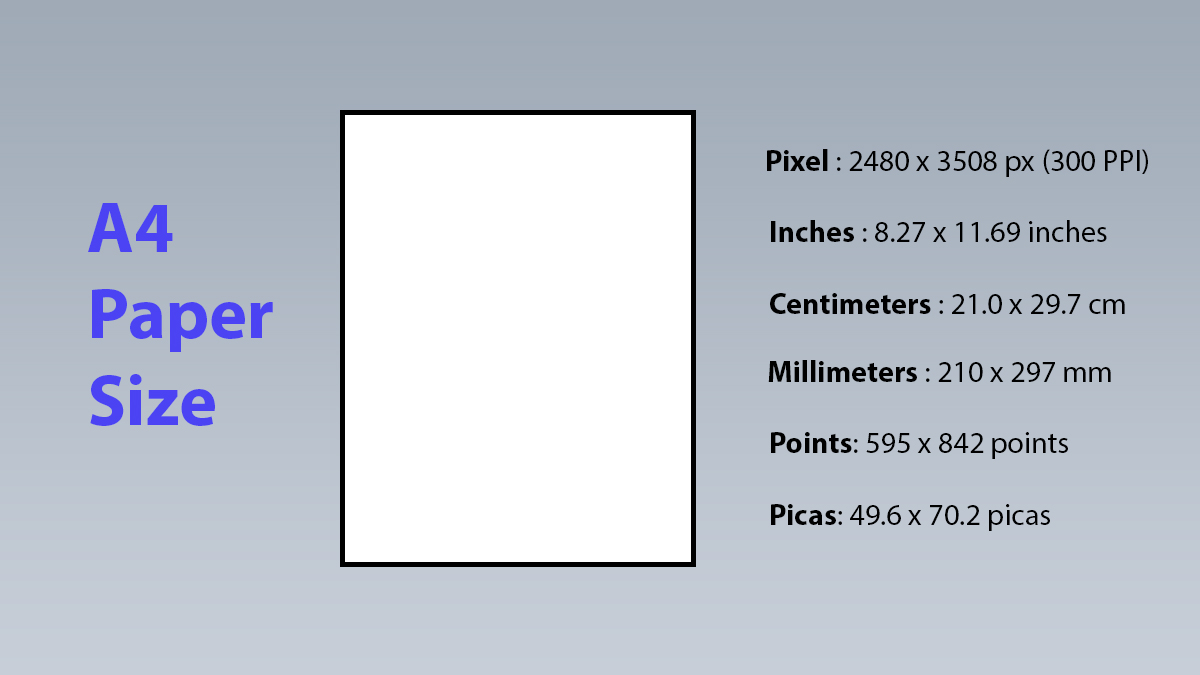A4 paper is more than just a standard sheet—it’s a global staple that powers everything from everyday printing to inspired creativity. Measuring 210 x 297 mm, this internationally recognized size plays a vital role in offices, classrooms, studios, and beyond. Whether you’re drafting reports, designing flyers, or sketching your next masterpiece, A4 offers the perfect balance of functionality and flexibility. In this complete guide, we’ll break down the exact dimensions, explore its widespread uses, and share innovative ways to use A4 paper for creative projects. No matter your profession or passion, understanding the potential of A4 paper can transform how you work, create, and communicate. Let’s uncover what makes this iconic format so essential.
A4 Paper Dimensions and Specifications
A4 paper, a staple in offices, schools, and homes, measures exactly 210 x 297 millimeters or 8.27 x 11.69 inches. This specific dimension adheres to the ISO 216 standard, a globally recognized size system for paper. The A-series paper sizes, including A4, are defined by the German Institute for Standardization (DIN) in 1922 and later adopted internationally in 1975. The unique aspect of A-series paper is that each size is half the area of the next largest size. This means if you fold an A3 sheet in half, you get two A4 sheets, and so on. The aspect ratio of the A-series is always the square root of two (1:√2), which facilitates scaling and consistent enlargement or reduction in copying and printing tasks.
The precision of A4 paper dimensions makes it an ideal choice for a wide range of applications, from printing documents to creating artworks. The 210 x 297 mm size fits comfortably in the hand and is suitable for most standard printers and copiers. Additionally, the A4 size’s aspect ratio allows for efficient use of space, minimizing waste and ensuring a professional appearance in printed materials. Understanding the exact dimensions of A4 paper is crucial for anyone involved in design, printing, or any other field where paper usage is essential.
A4 paper is typically available in various weights and finishes, ranging from lightweight, 70gsm paper ideal for internal documents to heavier, 120gsm or higher paper suited for presentations and high-quality prints. The versatility of A4 paper extends to its compatibility with numerous printing technologies, including inkjet and laser printers. Whether you need to print a simple text document, a vibrant photo, or an intricate design, A4 paper can handle the task efficiently. This adaptability ensures that A4 remains the go-to choice for both everyday and specialized printing needs.
History and Standardization of A4 Paper
The history of A4 paper can be traced back to the early 20th century when the need for a standardized paper size became apparent. Before the introduction of the A-series, paper sizes varied significantly from country to country, leading to inefficiencies and confusion. In 1922, the German engineer Dr. Walter Porstmann proposed the DIN 476 standard, which established a systematic approach to paper sizes based on the aspect ratio of 1:√2. This standardization not only simplified paper production but also revolutionized the printing and publishing industries.
The DIN 476 standard was eventually adopted by the International Organization for Standardization (ISO) in 1975, leading to the creation of the ISO 216 standard. This standard encompasses the A, B, and C series of paper sizes, with the A-series being the most widely used. The adoption of ISO 216 marked a significant milestone in the global standardization of paper sizes, facilitating international trade and communication. Today, A4 paper is the default choice in most countries, except for the United States and Canada, where the Letter size (8.5 x 11 inches) remains prevalent.
The standardization of A4 paper has had a profound impact on various industries, from publishing and printing to education and office administration. By providing a consistent and universally recognized paper size, the ISO 216 standard has streamlined processes, reduced costs, and improved efficiency. The widespread adoption of A4 paper has also contributed to environmental sustainability by minimizing waste and optimizing resource use. Understanding the history and standardization of A4 paper offers valuable insights into its enduring popularity and significance in modern society.
Common Uses of A4 Paper in Everyday Life
A4 paper is an indispensable part of daily life, serving a multitude of purposes in various settings. In homes, A4 paper is commonly used for printing and copying documents, creating to-do lists, and producing handwritten notes. The size is perfect for fitting into standard folders and binders, making it easy to organize and store important papers. Additionally, A4 paper is often used for personal projects such as crafts, scrapbooking, and DIY decorations, providing a versatile and accessible medium for creativity.
In educational institutions, A4 paper is the standard choice for assignments, exams, and other academic activities. Students use A4 paper for taking notes, writing essays, and completing homework, while teachers rely on it for preparing lesson plans, handouts, and grading papers. The uniform size of A4 paper ensures consistency and ease of handling, whether for printing, copying, or distributing materials. This consistency is particularly important in educational settings, where clear communication and organization are essential for effective learning.
A4 paper also plays a crucial role in the world of business and professional settings. From printing contracts and reports to creating marketing materials and presentations, A4 paper is the go-to choice for a wide range of office tasks. Its standard size makes it compatible with most office equipment, including printers, copiers, and scanners, ensuring seamless workflow and productivity. Whether used for internal communications or client-facing documents, A4 paper provides a professional and polished appearance, reinforcing the credibility and reliability of the business.
A4 Paper in Business and Professional Settings
In the business world, A4 paper is the backbone of daily operations, facilitating communication, documentation, and record-keeping. One of its primary uses is for printing and distributing business documents such as contracts, invoices, reports, and proposals. The standardized size of A4 paper ensures that these documents are easy to handle, store, and reference, providing a consistent format that enhances professionalism and efficiency. Additionally, A4 paper is ideal for creating marketing materials such as brochures, flyers, and newsletters, which can be easily designed, printed, and distributed to clients and stakeholders.
A4 paper is also essential for creating and maintaining internal documents, including meeting agendas, employee handbooks, and training materials. The uniform size allows for easy organization and storage, whether in physical filing systems or digital archives. In professional settings, A4 paper is often used for preparing presentations, whether printed as handouts or projected during meetings. The versatility and compatibility of A4 paper with various office equipment make it an indispensable tool for ensuring smooth and efficient business operations.
Moreover, A4 paper plays a vital role in legal and regulatory compliance. Many legal documents, such as contracts, agreements, and official correspondence, are printed on A4 paper to ensure a consistent and professional appearance. The standardized size also simplifies the process of copying, scanning, and faxing these documents, which is crucial for maintaining accurate records and adhering to regulatory requirements. In industries where documentation and record-keeping are paramount, A4 paper provides a reliable and efficient solution for managing critical information.
Creative Applications of A4 Paper
Beyond its practical uses, A4 paper serves as a blank canvas for a wide range of creative applications. In the world of art, A4 paper is a popular choice for drawing, painting, and sketching. Its smooth surface and manageable size make it ideal for artists of all skill levels, from beginners to professionals. A4 paper can be used with various media, including pencils, pens, markers, and watercolors, allowing artists to experiment and express their creativity. Additionally, A4 paper is often used for creating detailed illustrations, graphic designs, and mixed media projects.
A4 paper is also a favorite among crafters and DIY enthusiasts. Its versatility makes it perfect for creating greeting cards, origami, paper flowers, and other handmade projects. The standard size of A4 paper ensures that it can be easily folded, cut, and manipulated to create intricate designs and patterns. For those who enjoy scrapbooking, A4 paper provides a convenient and accessible medium for preserving memories and creating personalized layouts. With a little imagination and creativity, the possibilities for using A4 paper in crafting are virtually limitless.
In the world of digital art and design, A4 paper plays a crucial role in the creation and presentation of work. Graphic designers often use A4 paper for printing mock-ups, prototypes, and final designs. The standardized size ensures that printed materials look professional and are easy to handle. Additionally, A4 paper is commonly used for printing photographs, whether for personal use or professional portfolios. The high-quality finish and compatibility with various printing technologies make A4 paper an excellent choice for showcasing digital art and photography.
Environmental Impact of A4 Paper Production
The production and consumption of A4 paper have significant environmental implications, from deforestation to energy consumption and waste generation. The paper industry is one of the largest consumers of wood, with vast quantities of trees harvested to produce paper products. This deforestation can lead to habitat loss, reduced biodiversity, and increased carbon emissions. Additionally, the paper manufacturing process requires substantial amounts of water and energy, contributing to the depletion of natural resources and the generation of greenhouse gases.
To mitigate the environmental impact of A4 paper production, many companies are adopting sustainable practices and seeking eco-friendly alternatives. One approach is to use recycled paper, which reduces the demand for virgin wood and conserves natural resources. Recycled A4 paper is made from post-consumer waste, such as old newspapers and office paper, and is processed to remove inks and contaminants. This process not only reduces the environmental footprint of paper production but also helps divert waste from landfills.
Another important aspect of sustainable paper production is the use of certified paper products. Certification programs, such as the Forest Stewardship Council (FSC) and the Programme for the Endorsement of Forest Certification (PEFC), ensure that paper products are sourced from responsibly managed forests. These certifications promote sustainable forestry practices, protect wildlife habitats, and support the livelihoods of local communities. By choosing certified A4 paper, consumers and businesses can support environmentally responsible practices and contribute to the preservation of forests for future generations.
Alternatives to A4 Paper Size
While A4 paper is the most widely used paper size globally, there are several alternatives that cater to specific needs and preferences. One common alternative is the Letter size (8.5 x 11 inches), which is predominantly used in the United States and Canada. The slightly different dimensions of Letter size paper can affect the layout and formatting of printed materials, making it important to choose the appropriate size based on the intended use and regional standards.
Another alternative is the Legal size (8.5 x 14 inches), which is often used for legal documents, contracts, and agreements. The extra length of Legal paper size paper provides additional space for detailed information and signatures, making it suitable for formal and official documents. Similarly, the Tabloid size (11 x 17 inches) is commonly used for creating large-format prints, posters, and brochures. The larger dimensions of Tabloid size paper allow for more creative freedom and the inclusion of visual elements, making it ideal for marketing and promotional materials.
For specialized applications, there are also non-standard paper sizes that cater to specific industries and requirements. For example, the A3 size (297 x 420 mm) is often used for creating architectural drawings, engineering plans, and large-format presentations. The B-series paper sizes, which include B5 (176 x 250 mm) and B4 (250 x 353 mm), are used for printing books, magazines, and other publications. Understanding the various paper sizes and their applications can help you choose the right paper for your specific needs and ensure optimal results in your projects.
Tips for Choosing the Right Paper Type
Choosing the right paper type is essential for achieving the desired results in your projects, whether for professional, educational, or creative purposes. One of the key factors to consider is the paper weight, which is measured in grams per square meter (gsm). Lighter paper, such as 70gsm or 80gsm, is suitable for everyday printing and copying tasks, while heavier paper, such as 120gsm or 160gsm, is ideal for high-quality prints, presentations, and marketing materials. Understanding the appropriate paper weight for your needs can enhance the appearance and durability of your documents.
Another important consideration is the paper finish, which can significantly impact the look and feel of your printed materials. Common finishes include matte, glossy, and satin. Matte paper has a non-reflective surface, making it suitable for text-heavy documents and professional reports. Glossy paper, on the other hand, has a shiny finish that enhances the vibrancy and sharpness of images, making it ideal for photographs and graphics. Satin paper offers a balance between matte and glossy finishes, providing a smooth surface with a subtle sheen that is suitable for both text and images.
Additionally, it’s important to consider the paper’s compatibility with your printing technology. Different types of printers, such as inkjet and laser printers, have specific requirements for paper types. Inkjet printers work well with a variety of paper finishes, including glossy and matte, while laser printers are best suited for smooth, high-quality paper that can withstand the heat of the printing process. Checking the manufacturer’s recommendations and conducting test prints can help ensure that you choose the right paper type for your printer and achieve optimal printing results.
Conclusion: Embracing the Versatility of A4 Paper
In conclusion, A4 paper stands out as a versatile and indispensable medium that transcends its humble dimensions to offer a wide range of applications in everyday life. From its precise dimensions and standardized history to its common uses in homes, schools, and businesses, A4 paper has proven its worth in various settings. Its adaptability extends to creative applications, where it serves as a canvas for artists, crafters, and designers to bring their ideas to life. Moreover, understanding the environmental impact of A4 paper production and exploring sustainable alternatives can help reduce our ecological footprint and promote responsible consumption.
Choosing the right paper type is crucial for achieving the best results in your projects, whether for professional documents, educational materials, or creative endeavors. By considering factors such as paper weight, finish, and compatibility with printing technology, you can ensure that your printed materials look polished and professional. A4 paper’s standardized size and versatility make it a reliable choice for various tasks, from everyday printing and copying to specialized applications and artistic creations.
As we continue to embrace the versatility of A4 paper, it’s important to recognize its potential to inspire and elevate our work. Whether you’re a student, teacher, business professional, or budding artist, understanding the many possibilities that A4 paper holds can enhance your productivity and unleash your creative flair. So, the next time you reach for a sheet of A4 paper, remember that it’s more than just a rectangular piece of paper—it’s a gateway to endless opportunities and a testament to the power of standardization and innovation.






